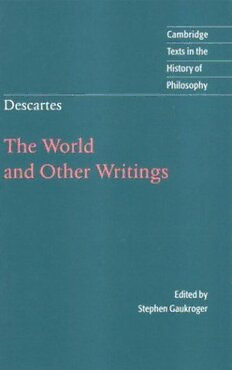
Descartes: The World and Other Writings PDF
247 Pages·1998·1.721 MB·English
Most books are stored in the elastic cloud where traffic is expensive. For this reason, we have a limit on daily download.
Preview Descartes: The World and Other Writings
Description:
Forget what you thought you learned in your freshman survey of Western philosophy about the Descartes whose thought so nicely compliments "the Matrix".Descartes spent a great deal of time in his other major works such as "The Discourse on Method", "The Principles of Philosophy", and even the "Meditations" trying to prepare his audiences for the mechanist theory he had already worked out in this work, which includes "The Treatise on Light "and "The Treatise on Man". My advice to you is to cut to the chase; this work is what Descartes was really about."The World" was never published during Descartes's lifetime, having been suppressed after the 1633 condemnation of Galileo. In the first section, Descartes presents through the imaginary figure of a "new world" a mechanist explanation of the universe and its intricate system of vorticies, in which he does his best to refute both the seventeenth century atomist and the long-reigning Aristotelian Scholasticism's cosmological theories. Similarly, in the "The Treatise on Man", Descartes describes, through the heuristic of an imaginary automatist machine, the functions of the human body, including comprehensive accounts of sensation, the circulatory system, and the nervous system (what Descartes famously calls "the animal spirits").The fact is, Descartes' metaphysics largely simplify Medieval accounts and just reiterate what every Jesuit would have been learning in school anyway. His mechanist physics is what was new and exciting about his work within the context of the seventeenth century. If you are interested in the history of philosophy or science, you will be doing yourself a great service to familarize yourself with this work.
See more
The list of books you might like
Most books are stored in the elastic cloud where traffic is expensive. For this reason, we have a limit on daily download.
